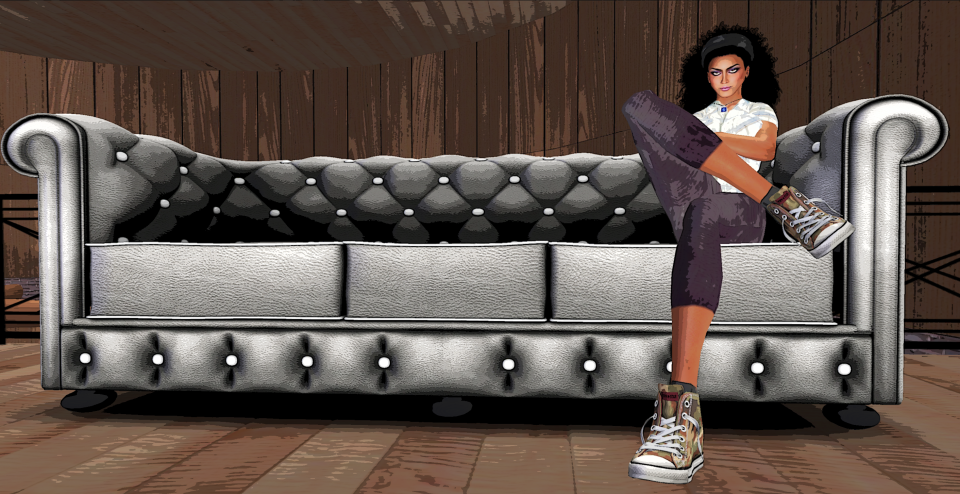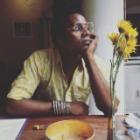
Image source: Second Life avatar of Nadika Nadja
THE QUEER SUBJECT AND VIOLENCE IN ONLINE AND OFFLINE SPACES
There’s a double-bind with gender non-conforming, non-binary, queer individuals and their route to claiming spaces – online and offline – because it necessitates visibility. It demands that the idiosyncrasies of “this subject” must be recognised to reward them their rights. The particular bind being that one’s visualness promises personal pleasure but also produces public punishment. In that sense, the anonymity of the early days of the online space allowed for the playing out of fantasy without the frustration of inhabiting it. “While offline, I may not pass as a woman – in the online space, it was possible to occupy this position without constant anxiety,” says Nadika Nadja, a trans-woman writer and researcher, currently based in Bangalore.
The particular bind being that one’s visualness promises personal pleasure but also produces public punishment.
“Though Twitter had less of a gap in terms of inhabiting offline and online. On this platform, I was known more for my ideas, my tweets being anti-government rather than being a visual being. In my year on Instagram though, initially, it did attract men, who fetishised me, who would ask me questions like, “Hey! What are your charges?” or hit on me. But ever since switching my Instagram account to private, I’ve been able to avoid this kind of unwanted attention,” adds Nadika.
Delhi-based researcher Vikram Aditya Sahai, who works at the intersection of gender, sexuality and housing, echoes this shift in being publicly accepted: depending on if one is transmitting one’s ideas through text or through the image. “Facebook was my first consistent presence in the online space. Over here, a bunch of selves came together – teacher, student, political self and the person curating discursive conversations from around the Internet,” she said. “On Facebook, the hate or nastiness came in response to my political positions. The politics complicated the queer. Though, on Instagram, I ended up being seen as flesh rather than word. The success of the “visuality of gender” positions you in the world: image first. While even on the Delhi Metro, it is the visual first – it depends whether I’m wearing a sari or jeans-and-a-tee, it depends on which entry of the “binary security system” I choose to use. Though, here I’m able to negotiate it. On Instagram, though, there isn’t a room for that, instead on the basis of the visual, one could be on the receiving end of a barrage of hate messages, or being called “hideous” or attacks in the vein of what the liberal feminist might call “body-shaming”. This space seems to act as a repository to collect deeply projected sexual violence.”

Image source: Vikram Aditya Sahai (Instagram)
HAI SEXY. WANT TO DO SEX?
For Alok Vaid-Menon, an Indian-American gender non-conforming performance artist, writer, educator, and entertainer, offline and online violence are both intense in their own ways. “Online violence can feel particularly painful because the internet is where I have gone for so long to find safety/community/recognition – my creative space. When that space is under threat it's a reminder of how fraught the question of safety is more generally,” they wrote in our email interview. They continued to say, “Offline violence is also incredibly debilitating because every day I don't know what kind of transmisogyny I'm going to encounter – navigating the public requires submitting myself to the whims, anxieties, and fantasies of strangers, knowing that other strangers will not defend me when I am verbally/sexually/physically assaulted. Both facilitate a constant sense of anxiety and fear – the threat of violence constantly looms and shapes so much of how I navigate space.”

Image source: Alok Vaid Menon
While Vikram believes that it is “these very consequences that actually make it worth it”. She believes that in order for gender to be read, seen, challenged and pushed, it is important for “gender expression” to trigger some kind of response. “The promise of Instagram is that success at it is presented as democratic but rather it reveals the ways gender might be humoured while it is persecuted in the “real world”. Instagram turns “queerness” into a kind of acquired taste, or distinction, and in that way “queerness” is the perfect vessel for holding up the notions of uniqueness or specialness that this platform wants to propagate,” she explains.
Therefore, she finds the moments of tussle between “queerness” and Instagram far more interesting and telling: she finds the moments that she provokes someone into doing something extra, like leaving a comment, quite satisfying. “Distance dilutes the feeling of threat in the online space. It makes it seem like the threat can be managed, one can take the time to prepare, to respond, to react. There’s more possibility for the accidental in the offline space – on the street, in the city – I don’t censor myself with clothing or movement in these places. I’ve come to see that incase something happens, I’ve got the wherewithal and skill set to do something about it in that moment,” she says. “I’ve found face-to-face interactions with those trolling me on my Instagram account to be quite different and non-threatening,” she adds quickly, and laughs. “I’ve come to see that to live life in the ways that challenge gender means that one must accept violence. Violence is the only evidence that one is disrupting gender,” she says.
I’ve come to see that to live life in the ways that challenge gender means that one must accept violence. Violence is the only evidence that one is disrupting gender
I’M REAL, BABY
While everyone agrees that violence is default, the online space does continue to work as a practice ground for the performance of gender in the offline, according to Nadika. “In order to escape the shame of being a transwoman growing up in a middle-class, Tamilian Brahmin family, I dove into Second Life. Over here, I experienced the unending possibilities to be the woman I wanted to be, to be seen as that woman by others, and to own that idea of being a women through community,” she says. “Finding a community on Second Life to freely discuss my transitions, my joys and fears around it gave me the push to put it out there in the real world. It functioned as an echo chamber providing me with the strength to look at myself,” she adds.
Finding a community on Second Life to freely discuss my transitions, my joys and fears around it gave me the push to put it out there in the real world. It functioned as an echo chamber providing me with the strength to look at myself

Image source: Nadika (Instagram)
Though all three of the interviewees could not separate the idea of gender from violence and vice-versa, they had different takes on how to deal with the status quo. “So then the work might be to create a world where gender doesn’t have bearing on our personhood – where we find ways to experience one another’s complexity and infinite potential for transformation outside of limited frames of gender,” says Alok. “In regard to social media’s relationship with this: it's not an either/or. It can help enable this (by allowing people to tell stories of themselves, their histories...and thereby breaking down the idea that we can be defined by a word) but it can also hinder this (by collapsing the vast entirety of who we are into the image),” they add.
The work might be to create a world where gender doesn’t have bearing on our personhood – where we find ways to experience one another’s complexity and infinite potential for transformation outside of limited frames of gender
Though, Vikram proceeds to provide another shade of complication, “For me, moving around in a sari, skirt or salwar-kameez isn’t because being wrapped in these fabrics is a truer version of myself. The clothing is an invitation to speculation, to even violence. The precise thing I want is the public reaction – a questioning stare, stuffy silence, awkwardness and discomfort,” she explains. “I’d be rather disappointed if I didn’t get any reaction,” she quips.

Image source: Vikram Aditya Sahai(Instagram)
While Nadika agrees and even commends these political positions, she finds herself (maybe like most others) attempting to fit-in, to seek approval, to find confirmation, which have their own sets of violences, though she hopes that, “while some parts of me might break on account of the violence, I hope that in putting myself back together, there are fewer scars”.
I hope that in putting myself back together, there are fewer scars
- 7848 views






Add new comment